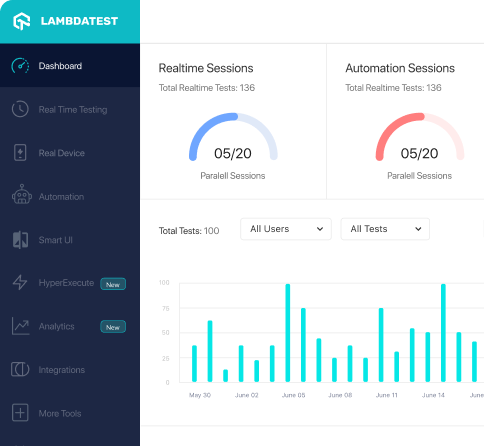How to use KubernetesExecuteIT class of com.consol.citrus.kubernetes.integration package
Best Citrus code snippet using com.consol.citrus.kubernetes.integration.KubernetesExecuteIT
Source:KubernetesExecuteIT.java
...22 * @author Christoph Deppisch23 * @since 2.724 */25@Test26public class KubernetesExecuteIT extends AbstractKubernetesIT {27 @CitrusXmlTest(name = "KubernetesExecuteIT")28 public void kubernetesExecuteIT() {29 }30}...KubernetesExecuteIT
Using AI Code Generation
1import com.consol.citrus.annotations.CitrusTest2import com.consol.citrus.dsl.junit.JUnit4CitrusTestDesigner3import com.consol.citrus.kubernetes.integration.KubernetesExecuteIT4import com.consol.citrus.kubernetes.message.KubernetesMessageHeaders5import com.consol.citrus.message.MessageType6import org.springframework.http.HttpStatus7import org.springframework.http.MediaType8import org.springframework.web.client.RestTemplate9import org.springframework.web.client.getForEntity10class MyKubernetesExecuteIT : JUnit4CitrusTestDesigner() {11 fun kubernetesExecuteIT() {12 val restTemplate = RestTemplate()13 echo("Status code: ${response.statusCode}")14 echo("Response body: ${response.body}")15 variable("namespace", "citrus")16 variable("podName", "test-pod")17 variable("containerName", "test-container")18 variable("containerPort", "8080")19 http()20 .client("kubernetesClient")21 .send()22 .post()23 .fork(true)24 .payload("{\"kind\":\"Pod\",\"apiVersion\":\"v1\",\"metadata\":{\"name\":\"${podName}\"},\"spec\":{\"containers\":[{\"name\":\"${containerName}\",\"image\":\"citrusframework/citrus-http:latest\",\"ports\":[{\"containerPort\":${containerPort}}]}]}}")25 .contentType(MediaType.APPLICATION_JSON_VALUE)26 http()27 .client("kubernetesClient")28 .receive()29 .response(HttpStatus.CREATED)30 .messageType(MessageType.JSON)31 kubernetes()32 .client("kubernetesClient")33 .send()34 .get("/api/v1/namespaces/${namespace}/pods/${podName}")35 .header(KubernetesMessageHeaders.KUBERNETES_OPERATION_NAME, "getPod")36 kubernetes()37 .client("kubernetesClient")38 .receive()39 .response(HttpStatus.OK)40 .messageType(MessageType.JSON)41 .payload("{\"kind\":\"Pod\",\"apiVersion\":\"v1\",\"metadata\":{\"name\":\"${podName}\"},\"spec\":{\"containers\":[{\"name\":\"${containerName}\",\"image\":\"citrusframework/citrus-http:latest\",\"ports\":[{\"KubernetesExecuteIT
Using AI Code Generation
1import com.consol.citrus.dsl.junit.JUnit4CitrusTestDesigner;2import com.consol.citrus.kubernetes.integration.KubernetesExecuteIT;3import com.consol.citrus.kubernetes.message.KubernetesMessageHeaders;4import com.consol.citrus.message.MessageType;5import com.consol.citrus.testng.CitrusParameters;6import org.testng.annotations.Test;7public class MyKubernetesIT extends JUnit4CitrusTestDesigner {8 @CitrusParameters({"namespace", "podName"})9 public void testPodStatus(String namespace, String podName) {10 variable("namespace", namespace);11 variable("podName", podName);12 send(new KubernetesExecuteIT.KubernetesActionBuilder()13 .action(KubernetesExecuteIT.KubernetesAction.GET_POD_STATUS)14 .namespace("${namespace}")15 .podName("${podName}")16 .build());17 receive(new KubernetesExecuteIT.KubernetesActionBuilder()18 .action(KubernetesExecuteIT.KubernetesAction.GET_POD_STATUS)19 .namespace("${namespace}")20 .podName("${podName}")21 .messageType(MessageType.JSON)22 .header(KubernetesMessageHeaders.KUBERNETES_STATUS_CODE, "200")23 .payload("classpath:com/consol/citrus/kubernetes/integration/pod-status.json")24 .build());25 }26}27The KubernetesExecuteIT class provides a fluent API to construct the action message. The action() method is used to set the Kubernetes action to be executed. The namespace() method is used to set the Kubernetes namespace. The podName() method is used to set the pod name. The payload() method is used to set the message payload. The header() method is used to set theKubernetesExecuteIT
Using AI Code Generation
1import com.consol.citrus.dsl.testng.TestNGCitrusTestDesigner2import org.springframework.beans.factory.annotation.Autowired3import org.springframework.beans.factory.annotation.Value4import org.springframework.core.io.Resource5import org.springframework.http.HttpStatus6import org.springframework.http.MediaType7import org.springframework.web.client.RestTemplate8import org.testng.annotations.Test9class KubernetesExecuteIT extends TestNGCitrusTestDesigner {10 @Value('classpath:com/consol/citrus/kubernetes/integration/k8s.yml')11 @Value('classpath:com/consol/citrus/kubernetes/integration/k8s2.yml')12 @Value('classpath:com/consol/citrus/kubernetes/integration/k8s3.yml')13 @Value('classpath:com/consol/citrus/kubernetes/integration/k8s4.yml')14 @Value('classpath:com/consol/citrus/kubernetes/integration/k8s5.yml')15 @Value('classpath:com/consol/citrus/kubernetes/integration/k8s6.yml')16 @Value('classpath:com/consol/citrus/kubernetes/integration/k8s7.yml')17 @Value('classpath:com/consol/citrus/kubernetes/integration/k8s8.yml')18 @Value('classpath:com/consol/citrus/kubernetes/integration/k8s9.yml')19 @Value('classpath:com/consol/citrus/kubernetes/integration/k8s10.yml')20 @Value('classpath:com/consol/citrus/kubernetes/integration/k8s11.yml')21 @Value('classpath:com/consol/citrus/kubernetes/integration/k8s12.yml')22 @Value('classpath:com/consol/citrus/kubernetes/integration/k8s13.yml')23 @Value('classpath:com/consol/cKubernetesExecuteIT
Using AI Code Generation
1import com.consol.citrus.annotations.CitrusXmlTest2import com.consol.citrus.kubernetes.integration.KubernetesExecuteIT3import com.consol.citrus.testng.CitrusParameters4import org.testng.annotations.Test5class KubernetesIT extends KubernetesExecuteIT {6 @CitrusParameters("kubernetes.test.createPod")7 @CitrusXmlTest(name = "KubernetesIT")8 void testCreatePod() {9 }10}Blogs
Check out the latest blogs from LambdaTest on this topic:
Have you ever visited a website that only has plain text and images? Most probably, no. It’s because such websites do not exist now. But there was a time when websites only had plain text and images with almost no styling. For the longest time, websites did not focus on user experience. For instance, this is how eBay’s homepage looked in 1999.
Manual cross browser testing is neither efficient nor scalable as it will take ages to test on all permutations & combinations of browsers, operating systems, and their versions. Like every developer, I have also gone through that ‘I can do it all phase’. But if you are stuck validating your code changes over hundreds of browsers and OS combinations then your release window is going to look even shorter than it already is. This is why automated browser testing can be pivotal for modern-day release cycles as it speeds up the entire process of cross browser compatibility.
Sometimes, in our test code, we need to handle actions that apparently could not be done automatically. For example, some mouse actions such as context click, double click, drag and drop, mouse movements, and some special key down and key up actions. These specific actions could be crucial depending on the project context.
While there is a huge demand and need to run Selenium Test Automation, the experts always suggest not to automate every possible test. Exhaustive Testing is not possible, and Automating everything is not sustainable.
Web applications continue to evolve at an unbelievable pace, and the architecture surrounding web apps get more complicated all of the time. With the growth in complexity of the web application and the development process, web application testing also needs to keep pace with the ever-changing demands.
Automation Testing Tutorials
Learn to execute automation testing from scratch with LambdaTest Learning Hub. Right from setting up the prerequisites to run your first automation test, to following best practices and diving deeper into advanced test scenarios. LambdaTest Learning Hubs compile a list of step-by-step guides to help you be proficient with different test automation frameworks i.e. Selenium, Cypress, TestNG etc.
LambdaTest Learning Hubs:
- JUnit Tutorial
- TestNG Tutorial
- Webdriver Tutorial
- WebDriverIO Tutorial
- Protractor Tutorial
- Selenium 4 Tutorial
- Jenkins Tutorial
- NUnit Tutorial
- Jest Tutorial
- Playwright Tutorial
- Cypress Tutorial
- PyTest Tutorial
YouTube
You could also refer to video tutorials over LambdaTest YouTube channel to get step by step demonstration from industry experts.
Most used methods in KubernetesExecuteIT
Try LambdaTest Now !!
Get 100 minutes of automation test minutes FREE!!



